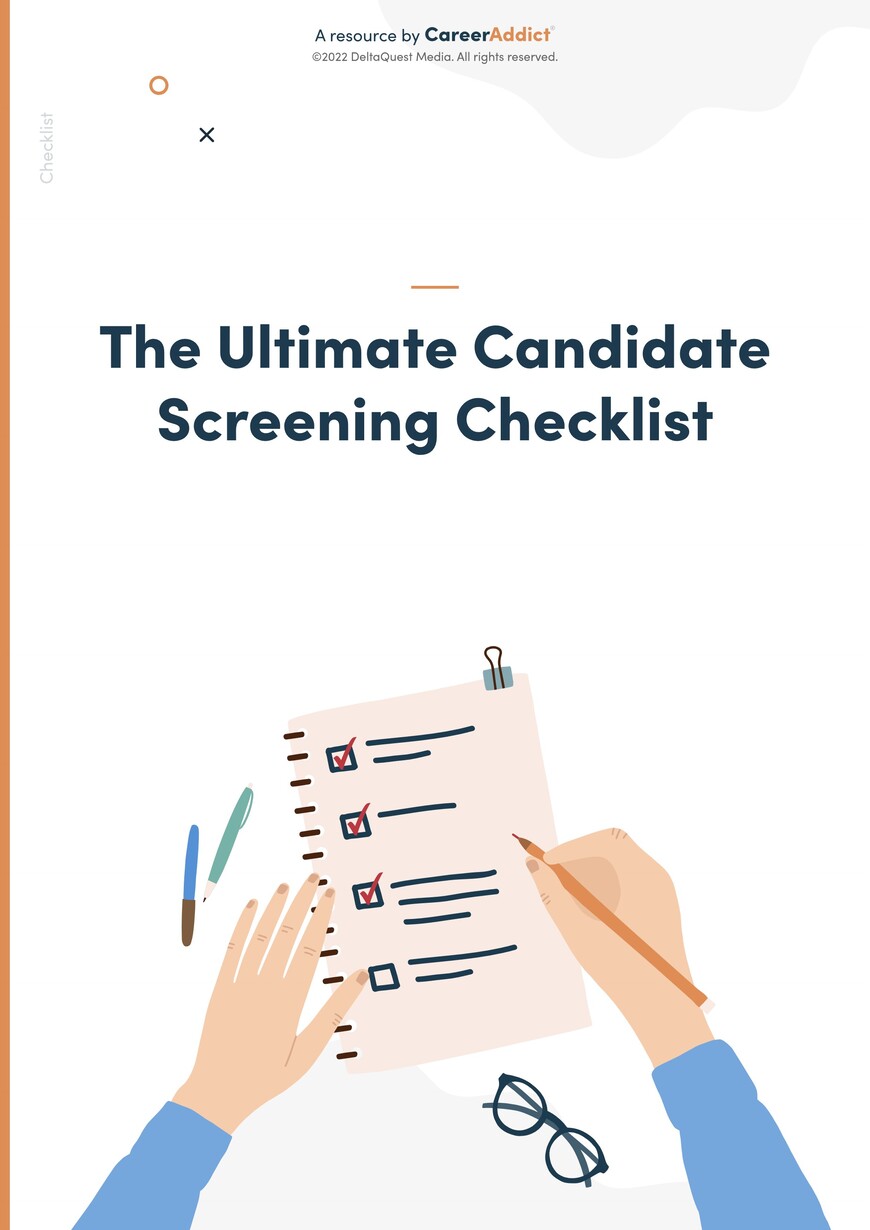For every job opening advertised, an average of 118 applicants will apply. However, not all applicants that apply for a specific job will be the right fit for the role. And even in the case that all applicants are qualified, there will usually be more applicants than there are open roles. This is why screening candidates is such an important aspect in any recruitment process.
Screening candidates refers to the process of determining whether a candidate meets the basic qualifications for a role. Through utilizing various tools, methods and techniques to screen, organizations can ensure that the candidates have the skillset, education and attributes required to be successful in the role.
Since employees are an organization’s greatest asset, effectively screening candidates is key to ensuring you are hiring the right people. That’s why we’ve compiled this helpful guide with top tips and a comprehensive checklist to help you more effectively screen candidates and hire top talent.
Why it’s important to screen candidates
There are a number of reasons why screening candidates for open roles is important. First and foremost, screening candidates ensures that the organization finds the most suitable person for the role. During the screening process, the organization can evaluate candidates’ education, skills and personal attributes to ensure they will be successful and fit well within the organizational culture.
However, in addition to ensuring the organization hires the most suitable people, there are some additional benefits to screening candidates:
- Saving time by progressing only qualified candidates through the recruitment process
- Reducing turnover by ensuring the hire has the skills required to effectively perform the role
- Protecting workplace culture and employee engagement by making sure the candidate is a good fit within the team and wider organization
Tips for screening candidates
Now that you’ve familiarized yourself with the importance of screening candidates, how can you ensure you are doing it effectively? Well, the truth is that screening candidates is not a perfect science. However, there are some tried and true methods that you can use to ensure you are effectively and efficiently screening candidates.
Below are ten actionable tips that you can implement to develop and optimize your candidate screening process:
1. Plan the recruitment process in advance
One of the most important steps in screening candidates is to plan out the recruitment strategies and process in advance, prior to inviting a candidate to the interview. Companies vary in terms of interview stages, formats and participants, so you’ll want to decide what the most appropriate process looks like for the particular role.
Oftentimes, the recruiter will invite the initial shortlisted candidates to a screening call to get a better understanding of the candidate’s motivation and relevant experience. If the candidate is a good fit, the next screening may be an assessment or an interview with the hiring manager.
It’s good practice to decide prior to meeting candidates how many stages there will be, with whom the interviews will take place and whether the interviews will be over a video call or in-person. You may even want to discuss the questions that will be asked during the interviews to ensure all bases are covered. For example, perhaps one interview could be based on culture fit and another interview to assess technical skills.
2. Establish screening criteria
To ensure you are fairly and effectively screening candidates, establishing screening criteria and a candidate profile is key. Creating a candidate profile involves developing a clear picture of the skills and attributes required for the role.
Once you have the candidate profile, you can then create a candidate scorecard to assess how closely the candidate aligns with the ideal profile. To make a candidate scorecard, first list the competencies, skills and attributes that are required or desired for the role.
When screening résumés, you can use this scorecard to indicate which candidates are best suited for the role by using a points system. Although a scorecard is not always a perfect system, it can increase objectivity, efficiency and fairness when evaluating applications.
3. Use descriptive and inclusive language when advertising
The first step in effectively screening candidates is to be sure you are only attracting applicants that meet the requirements of the role. By being as clear as possible when advertising the job specification, you can minimize the number of applications from unsuitable candidates.
One way to ensure you are being as clear and descriptive as possible is to state not only which requirements are essential, but also state which skills and attributes are desired but not absolutely necessary. However, be sure that the job description isn’t too specific that it deters applicants. A good job description should be more like a wish list than a checklist with requirements that every candidate must fulfill.
In addition to using descriptive language, it is important to also use gender neutral and inclusive language to ensure you’re attracting a diverse pool of candidates. For example, requiring a degree from a “top-tier university” could deter applicants with diverse socioeconomic backgrounds. And using terms with competitive or aggressive connotations may repel women from applying. Therefore, it’s a good idea to review your job description to ensure it attracts diverse candidates.
4. Utilize technology
Since the turn of the century, recruitment has come a long way — it is hard to imagine a world when job seekers would send in their applications by post. Nowadays, there are a multitude of different types of recruitment tools and technology to help organizations more efficiently and effectively screen candidates.
One easy way to ensure applications only come from suitable candidates is to include pre-screening questions as part of the online application process on either your website or an external job search platform. Applicant tracking systems or on-demand automated video interviews, such as HireVue, are other types of common recruitment tools to optimize candidate screening.
5. Be aware of cognitive biases
Despite the best intentions and efforts to be fair while screening candidates, sometimes unconscious cognitive biases can influence decision-making. An example of a cognitive bias during the recruitment process is giving preference to one candidate over the other because they went to the same university as you. However, oftentimes recruiters and hiring managers may not even be aware of these biases.
There are certain methods that you can use while recruiting to ensure you are impartially screening candidates. One effective strategy to reduce potential bias is blind recruitment, or blind screening, which essentially involves removing any identifiable characteristics from the hiring process. Information such as age, gender, academic background and address are hidden during the résumé screening process, so that candidates are evaluated solely on skills.
6. Consider using pre-employment assessments
Pre-employment tests are assessments that candidates are asked to take during the screening process. They can be advantageous in that they provide a measurable and fair way to compare candidates. Pre-employment assessments can also be a way to verify that the candidate actually possesses the skills required to perform the job.
However, pre-employment assessments may not be suitable for all jobs. For example, if you are recruiting a director with decades of industry experience, a pre-employment assessment would most likely not be appropriate. But if you are screening for a technical role, such as a software engineer, a practical coding assessment could be an effective way of assessing the candidate’s technical skills.
7. Screen for potential
Although screening candidates should ideally be a standardized process, it is important to ensure you aren’t be too rigid and overlooking high-potential candidates. For example, say a candidate falls a little short of the required years of experience, but shows a passion for the field and an ability to learn quickly — they may end up being a top performer and exceeding the expectations of the role, despite not meeting all requirements.
Therefore, it is important to view candidates holistically and consider their potential. Soft skills, such as initiative, emotional intelligence, motivation and interpersonal skills can, in some cases, be a better indicator of future job performance than technical skills or experience.
8. Pay attention to the details
Screening a candidate means that you have relatively few touchpoints with a potential hire, so you’ll want to make each one count. Make sure to pay attention to details and behavior throughout the screening process.
For example, was their application free of errors? Were they polite and displaying good written communication skills in their email correspondence? Although these may seem like minor details, they can provide insight into a candidate’s attention to detail and their level of motivation in making a good impression.
9. Perform a social media background check
While reference checks are typically part and parcel of screening and hiring candidates, many recruiters and organizations have started using another type of character verification — namely social media.
A social media background check involves reviewing a candidate’s public social media profiles to learn more about the candidate. As employees are essentially representatives of organizations, it is important to ensure hires will preserve the reputation of the employer.
However, when deciding whether to implement social media background checks into your candidate screening process, it is best to create a policy and run it by your legal team. With all screening practices, it is important to ensure fairness, consistency and that your organization is not unlawfully discriminating candidates.
10. Provide an excellent candidate experience
Be sure to keep in mind that recruitment processes are a two-way street. Candidates are also assessing you as a potential employer, so being transparent and organized throughout the interview process will be sure to make a good impression.
Even for the candidates who are not selected for the role, it is important to provide a positive experience. After all, they may be a good fit for another role at a later time and you want to maintain your reputation as an employer. Therefore, ensure you are being thoughtful and positive in your rejection letter so that your organization stays in good graces.
Candidate screening checklist
Since screening candidates is so important for the success of every organization, it requires thorough planning and consideration. To ensure you’re properly screening candidates and setting yourself up to make the best hire, we’ve compiled a handy candidate screening checklist that you can download.

Key takeaways
People are an organization’s greatest resource. But finding the right person to fill a role can be a challenge. Hiring a new employee not only requires sifting through sometimes hundreds of applications, but you want to make sure the process is fair, effective and efficient.
Through utilizing the above tips and strategies, you can ensure that your candidate screening process leads to the best hires for your organization. Some of the most important aspects to remember are:
- Plan the entire screening process in advance to ensure efficiency and transparency with candidates
- Be aware of unconscious biases and look for ways to minimize it during the screening process
- Ensure a positive candidate experience so as to not burn bridges with candidates who may re-apply
Screening candidates will require some time, effort and planning. However, by using the above tips and checklist, you can gain a competitive advantage when it comes to finding the best talent. And the satisfaction of hiring the perfect candidate for the role will make it all worth it in the end!

